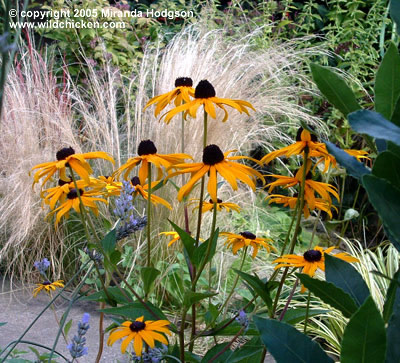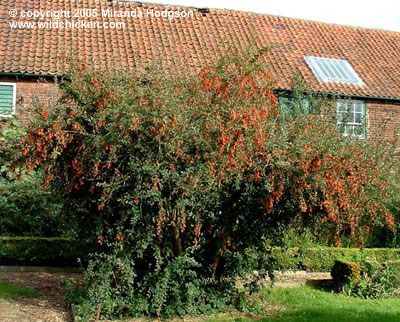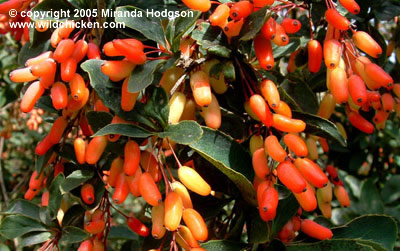September 16th 2005 - Wildlife and another mystery
One of the Rudbeckia fulgida var. sullivantii 'Goldsturm' plants that went into the ground recently has a self-seeded Stipa tenuissima behind it. I can see it from the kitchen window and, when the sun shines on the plants, both of them light up brilliantly.
"It’s a wonderful combination and I shall look to replicate elsewhere it for next year"
The Stipa, with its thread-fine, creamy-coloured, stems and leaves, seems to absorb light so that it seems to have an inner glow, whilst the sun reflects off the petals of the Rudbeckia so brightly that it makes you want to squint. It’s a wonderful combination and I shall look to replicate elsewhere it for next year. There is already some S. tenuissima which has established itself in the front sunny bed, and adding in R. ‘Goldsturm’ will give a lovely autumn display.

Rudbeckia 'Goldsturm' backed by Stipa tenuissima
Peeping into peoples’ gardens these last few weeks, I see that Rudbeckias are very popular this year, especially ‘Goldsturm’. I love the dark brown centres of the flowers and always think they look rather like blocks of eye make-up. You run your finger over the sheen of the central mound and expect to see the colour come away on your finger tip but it doesn’t, which is ever so slightly disappointing.
"...it adds welcome colour to a garden that may already have seen its best by this time of year"
Being a late summer plant, it adds welcome colour to a garden that may already have seen its best by this time of year. It’s also attractive to bees and butterflies, providing good foraging for them when there aren’t so many flowers still around. Regular deadheading will prolong the display, and the insects’ food supply.
Already the first frosts of the autumn are being forecast and we’re told to expect some during the next week or so. With the mixed weather, and the up-down temperatures we’ve had, it hasn’t been an especially good flowering year and we’ll soon be losing what summer flowers there have been. Last night and today feel distinctly autumnal, with the first chill in the air.
Along with the variety of plants in the garden, the wildlife population continues to expand. This year, for the first time, we’ve had a great many grasshoppers and it’s been a pleasure to sit on sunny days and hear that scratchy noise they make, or to see them sunbathing amongst the grasses.
"The thrill of the summer, as far as wildlife, goes was seeing my first hummingbird hawk moth"
The thrill of the summer, as far as wildlife, goes was seeing my first hummingbird hawk moth. It’s a day-time flying moth with a wingspan of up to 58mm (about two inches) and is noticeable for its dark brown and white abdomen and the orange undersides of its wings. It hovers over flowers just as a hummingbird does and uses its long proboscis to drink nectar. The wings beat so fast that all you see is a blur, which makes it very difficult to photograph.

The hummingbird hawk moth sticking its tongue out
When I saw it, I called to Karl and he came down from the office with the camera. As he followed it around the garden, I thought it must be moving too quickly for him to get a clear photo but, amongst the resulting blobs of fuzziness, there was one where you can clearly see the moth’s wing colour, and its long proboscis as it hovers over a honeysuckle flower.
Another new arrival was spotted, this time in the pond. At first we thought it was a long, thin slug which had fallen into the water and was trying to find a way out. Almost black, and about 2cm long, this creature was undulating through the water but, watching it for a little longer, it didn’t look like it was out of its natural environment and trying to escape. Could it be a leech? I got some books out and then carried out an internet image search and discovered that it was indeed a leech.
Going back for another look, we saw more of them. How they got there I’m not sure. I read that leeches can get into ponds when shop-bought pond plants have eggs attached to them, but we haven’t added any new plants for at least two years. The supermarket-bought watercress that I rooted and added in early summer would be an unlikely source, so they must have arrived with birds, toads or frogs.
There is a new mystery to be solved. This week I paid a visit to the gardens at Scawby Hall, near Brigg. The gardens are old and, until recently, were very run down. They still have a dilapidated charm and are worth a visit if you’re passing by to enjoy the peaceful atmosphere and to see how the refurbishment is coming along. If you like lavenders, there are 53 varieties currently grown.

The Berberis
"...Karl said he reckoned they were more like jelly beans and he was right – a jelly bean bush"
Standing at least 2.5m high and at least as wide, it was heavy with berries in all shades from pale green, through to yellow, orange and red. At first I thought they looked like tiny bananas, but Karl said he reckoned they were more like jelly beans and he was right – a jelly bean bush.

Jelly beans
At home, I tried to find out what type of Berberis it is, and the closest I came was Berberis vulgaris. Julie, Scawby Hall’s head gardener thought it was a named cultivar, but I couldn’t find a name for it in my search. If anyone is familiar with it, please do let me know.
© Copyright Miranda Hodgson 2005